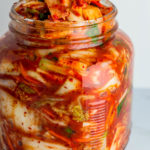Homemade Korean Vegan Kimchi
Homemade Korean Vegan Kimchi - perfectly vibrant, spicy, and sour with the hint of umami that will pair extremely well in any buddha bowls and fried rice.
- Prep Time: 3 hours
- Total Time: 3 hours
- Yield: about 5 pounds of kimchi 1x
- Category: Side Dish
- Method: Ferment
- Cuisine: Korean
- Diet: Vegan
Ingredients
Scale
- 1 large Napa cabbage, about 4 lb
- 1/2 cup + 2 tablespoons Korean coarse sea salt
- 1 cup of water
- 4 pieces (size of a deck of card) of Korean dried kelp (a.k.a Da-shi-ma)
- 2 tablespoons Sweet Rice flour (or all-purpose flour)
- 6-7 garlic cloves
- 2- 3 medjool dates (or 1 to 2 tablespoons sugar)
- 1/4 of a large onion, roughly chopped
- 1 small apple, roughly chopped
- 1-2 small red pepper (such as Aleppo pepper or any kinds of red pepper), optional
- 6 green onion, cut into 2-3 inch pieces
- 1 carrot, cut into match-stick
- 1 small size (1 lb) Korean radish, cut into small pieces
- 3/4 cup Korean red pepper flakes (Gochugaru)
Instructions
- Cut the cabbage in half, lengthwise. Cut them again lengthwise. Rinse the cabbage under cold water. Cut the cabbage into a big bite-size and transfer them into a big bowl. Sprinkle Korean coarse sea salt and toss them together so the salt covers all the cabbage pieces.
- Let the cabbage sit with salt for an hour or so. Toss the cabbage again. This ensures that all the cabbage pieces are salted evenly as possible. Let it sit for another hour.
- While you wait for the cabbage to be salted, prepare your vegetables, and make kimchi sauce.
- To make the kimchi sauce, boil 1 cup of water in a small saucepan. Once the water comes to a boil, add the dried kelp pieces and turn down the heat to a simmer and let it steep for 10 minutes.
- Take the kelp pieces out and add 2 tablespoons of sweet rice flour with constant stirring. The mixture will thicken in a couple of minutes. Once it thickens, remove the pan from the heat and let it cool to room temperature.
- In a big cup (you can use the measuring cup or use the cup that came with the immersion blender), add garlic cloves, Medjool dates, onion, apple, and red pepper (optional). Blend until they are smooth liquid (should have the consistency of an apple sauce). Transfer the liquid to a medium-size bowl.
- In a bowl, stir in sweet rice flour mixture (make sure that they are cool), 2 tablespoons of Korean coarse sea salt, and 4/3 cup of Korean red pepper flakes. Mix until everything is well incorporated.
- In a big bowl, gently mix your cut vegetables (green onion, carrot, and Korean radish) with kimchi sauce. Set aside.
- Rinse your salted cabbage under cold water. I added some cold water to the cabbage bowl and quickly rinsed them and transferred them into a big salad spinner bowl so the water can drain. Once all the cabbage pieces are rinsed, gently squeeze the water out of the cabbage and transfer them into a big bowl.
- Gently toss together the salted cabbage pieces with kimchi sauced vegetable mixtures. Use both of your hands to toss them together. Do not be rough with it.
- Once all the cabbage pieces are coated with kimchi sauce mixture, transfer them into a big container. DO NOT overfill the kimchi. Leave about 2-3 inches of room. You can enjoy the kimchi as is if you don't like sour/fermented kimchi. But if you are a fan of sour kimchi, let the container sit outside or let it sit on the countertop for a couple of days until it ferments.
Notes
- Check out my second version of vegan kimchi! It uses fewer ingredients!
- The addition of Aleppo red pepper is totally optional. It just adds little more spiciness and vibrance to the kimchi. It won't affect the overall taste of kimchi.
- If you want your kimchi to be on the milder side, please feel free to reduce the Korean red pepper flake amount to 1/2 cup.
- When mixing vegetables with the kimchi sauce, be gentle in mixing them together. When you are too rough mixing them, the vegetables may get mushy while fermenting. You still want your kimchi to have a crisp texture after fermentation.
- I believe the usage of dried kelp is essential in this recipe. Traditional kimchi is made with fish sauce and salted baby shrimps. Dried kelp is replacing those ingredients for the umami flavor to the kimchi.
Find it online: https://www.myeclecticbites.com/homemade-korean-vegan-kimchi/
